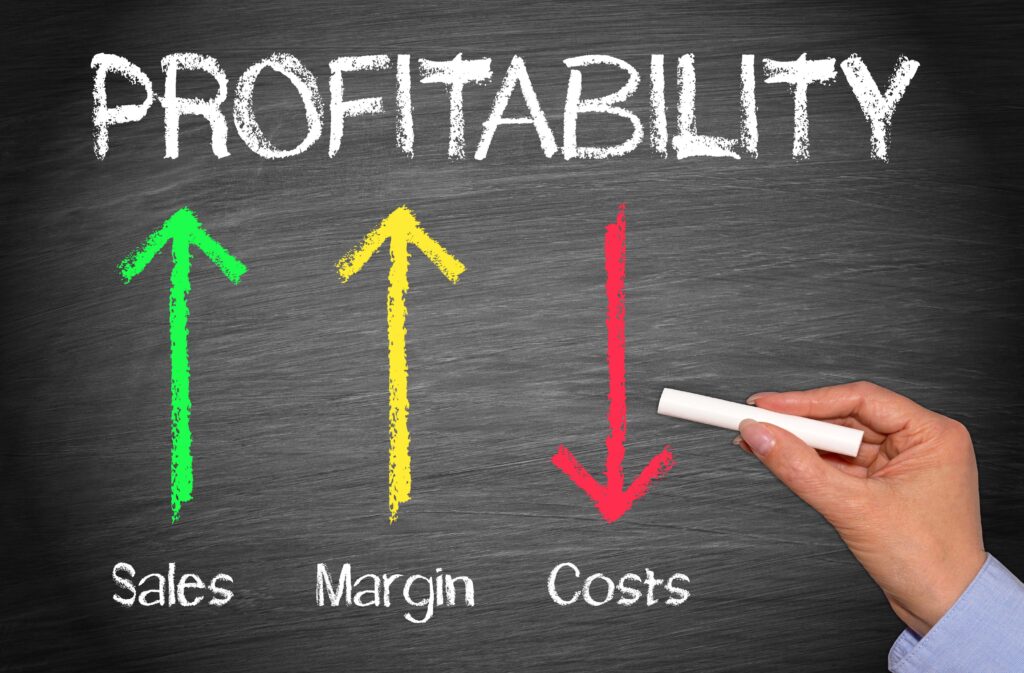There’s a whole lot more to owning a small business than what you see on the outside. For entrepreneurs, it’s exciting to turn your dream into a reality. However, running your own business requires a very solid understanding of the business side of things for it to be profitable and sustainable in the long term.
You’ve likely discovered early on that there are many financial elements to comprehend if you want your business to succeed. Profit margin is among the most vital of these and ensuring you calculate this correctly will mean you are able to maintain a sufficient cash flow to enjoy success.
Unfortunately, 82% of small businesses fail due to bad cash flow management. 50% fail within the first five years. Understanding how to calculate profit margin, whatever niche your business is in, can make or break your chance of succeeding.
Here’s a guide to calculating the profit margin for your small business:
What does profit margin mean?
The concept is relatively simple. Profit margin refers to how much your revenue exceeds your cost. In other words, it’s a measure of how much money the business has left after deducting the cost to provide your product or service.
What are business costs?
Profit margin measures the difference between your cost and revenue. It’s helpful to understand how costs are categorized before starting your profit margin calculation. There are three different cost categories that come into play:
- Cost of goods sold (COGS): This includes all expenses directly involved in the production of your business goods.
- Operating costs: Costs related to the operation of your business will be included here. Things like property overhead, capital, sales expenses, and other operational expenses.
- Net costs: Here, you’ll consider additional expenditures that aren’t directly involved in production and operation. This includes things like tax and debt.
These three costs are used to determine your overall profit margin. Identifying your costs and calculating profit margin can become tricky.
Business management suites like the one offered by Jobber are a really effective way for small business owners to manage every aspect of their business so that calculating profit margin is more manageable. The software is able to handle every aspect of business operations from invoicing to appointment scheduling, quoting and follow ups, online booking and credit card processing etc. so that business accounting, inclusive of profit margin can be easily obtained.
Three steps to calculating profit margin
Your overall profit margin equals three separate profit margins. Each individual margin considers different types of costs. At the end of the day, you’re left with an understanding of how much profit remains after all business expenses are paid. Here’s how these three profit margins differ:
- Gross profit margin.
Formula: (Total Revenue – COGS) / Total Revenue * 100
Essentially, this margin gives you an initial view of your profit after the cost of production.
Gross profit measures how much income remains after deducting the cost of producing/manufacturing the product or service you sell. In other words, your business’s COGS.
Examples of such expenses include the labor and raw materials. Other expenses like tax, operating costs, overhead, and debt aren’t a factor in your gross profit margin calculation.
- Operating profit margin.
Formula: (Operating Income / Total Revenue) * 100
Operating profit margin goes a step further than gross profit margin. Here you’ll calculate how much profit remains after factoring in all costs related to operating your business. Operating income is calculated by deducting your COGS and operating costs from your revenue.
Think about all the expenses necessary to keep the business running. All operating expenses indirectly related to production are included here. These expenses include overhead, sales expenses, operating, administration, and your other operational costs.
- Net profit margin.
Formula: (Total Revenue – COGS – Operation Expenses – Taxes – All additional expenses) / Total Revenue * 100
Net profit margin calculates how much profit remains after deducting COGS, operating expenses, and all other additional expenses not factored in previous calculations. This calculation will include expenses like tax, debt, property rental, and one-time expenses.
Your net profit margin shows how much your business makes after paying all expenses, displayed as a percentage. This is the central figure referred to when people talk about profit margin.
What is a good profit margin?
Every industry has different acceptable profit margins. Your profit margin doesn’t determine how much you’ll make. What it does is tell you how much you make per sale. For example, a net profit margin of 15% means you’ll earn USD$15 on a USD$100 sale. But your business may earn more overall than a business with a higher profit margin by making more sales.
According to Forbes, 10% is an average, healthy net profit margin. A 20% margin is considered high, while a 5% margin is considered low.
What does profit margin tell you?
In a nutshell, it allows you to gauge the health of your business cash flow. Businesses spend money to make money. As a small business owner, your profit margin compares how much you make to how much you spend.
While money isn’t everything, you probably want your business to support you at least. For instance, a low profit margin may be enough to keep the business running but doesn’t guarantee that you’ll earn enough to support yourself. If that’s the case, it may interest you to implement strategies to increase profitability.
Conclusion
Calculating your profit margin gives you valuable insight into how well your small business is doing. Profit margin is a figure representing how much you walk away with after covering all expenses. Most small businesses eventually fail, many due to poor financial management. As a small business owner, managing your profit margin from the start can help you beat the odds and build a successful business.

